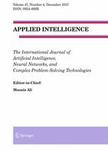版权所有:内蒙古大学图书馆 技术提供:维普资讯• 智图
内蒙古自治区呼和浩特市赛罕区大学西街235号 邮编: 010021

作者机构:Xian Univ Technol Dept Appl Math Xian 710054 Peoples R China Xian Univ Technol Sch Comp Sci & Engn Xian 710048 Peoples R China
出 版 物:《APPLIED INTELLIGENCE》 (Appl Intell)
年 卷 期:2023年第53卷第6期
页 面:6629-6670页
核心收录:
学科分类:08[工学] 0812[工学-计算机科学与技术(可授工学、理学学位)]
基 金:National Natural Science Foundation of China
主 题:Black widow optimization algorithm Q-Bezier surfaces Rectangular Bezier surfaces Shape parameters Surface conversion
摘 要:Bezier surfaces and Q-Bezier surfaces are effective modeling tools for shape design in computer-aided geometric design, computer vision, and computer graphics. The mutual conversion between these two kinds of surfaces is a pivotal and knotty technique in CAD/CAM. In this paper, the conversion between Q-Bezier surfaces and rectangular Bezier surfaces is investigated. However, due to the uncertain parameters of the Q-Bezier surfaces, the approximation conversion from rectangular Bezier surfaces to Q-Bezier surfaces can be regarded as an optimization problem, which is effectively dealt with by swarm intelligence algorithm. In this regard, an enhanced Black Widow Optimization called LDBWO is proposed to find more suitable shape parameters to obtain optimal approximation Q-Bezier surfaces, which are closer to the given Bezier surfaces. The LDBWO algorithm overcomes the shortcomings of standard BWO algorithm such as low accuracy, slow convergence, and is easy to fall into local optimum by introducing golden sine learning strategy and diffusion process. Furthermore, to confirm and validate the performance of the LDBWO, eight well-known intelligent algorithms are compared with the LDBWO on various benchmark functions and engineering examples. Finally, by minimizing the conversion error defined by the L-2-norm, the optimization model of the approximation conversion from rectangular Bezier surfaces to Q-Bezier surfaces is established. Several representative numerical examples are provided to illustrate the accuracy and efficiency of the proposed methods.